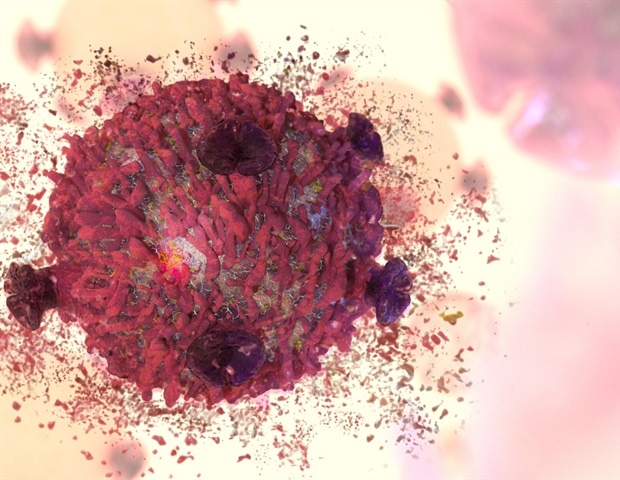Cell death plays an important role in normal human development and health but requires tightly orchestrated balance to avert disease. Too much can trigger a massive inflammatory immune response that damages tissues and organs. Not enough can interfere with the body's ability to fight infection or lead to cancer.
Zhigao Wang, PhD, associate professor of cardiovascular sciences at the University of South Florida Health (USF Health) Morsani College of Medicine, studies the complex molecular processes underlying necroptosis, which combines characteristics of apoptosis (regulated or programmed cell death) and necrosis (unregulated cell death).
During necroptosis dying cells rupture and release their contents. This sends out alarm signals to the immune system, triggering immune cells to fight infection or limit injury. Excessive necroptosis can be a problem in some diseases like stroke or heart attack, when cells die from inadequate blood supply, or in severe COVID-19, when an extreme response to infection causes organ damage or even death.
A new preclinical study by Dr. Wang and colleagues at the University of Texas Southwestern Medical Center identifies a protein complex critical for regulating apoptosis and necroptosis — known as protein phosphatase 1 regulatory subunit 3G/protein phosphatase 1 gamma (PPP1R3G/PP1γ, or PPP1R3G complex). The researchers' findings suggest that an inhibitor targeting this protein complex may help reduce or prevent excessive necroptosis.
The study was reported Dec. 3, 2021, in Nature Communications.
Cell death is very complicated process, which requires layers upon layers of brakes to prevent too many cells from dying. If you want to protect cells from excessive death, then the protein complex we identified in this study is one of many steps you must control."
Dr. Zhigao Wang, study principal investigator, member, USF Health Heart Institute
Dr. Wang and colleagues conducted experiments using human cells and a mouse model mimicking the cytokine storm seen in some patients with severe COVID-19 infection. They applied CRISPR genome-wide screening to analyze how cell function, in particular cell death, changes when one gene is knocked out (inactivated).
Receptor-interacting protein kinase (RIPK1) plays a critical role in regulating inflammation and cell death. Many sites on this protein are modified when a phosphate is added (a process known as phosphorylation) to suppress RIPK1's cell death-promoting enzyme activity. How the phosphate is removed from RIPK1 sites (dephosphorylation) to restore cell death is poorly understood. Dr. Wang and colleagues discovered that PPP1R3G recruits phosphatase 1 gamma (PP1γ) to directly remove the inhibitory RIPK1 phosphorylations blocking RIPK1's enzyme activity and cell death, thereby promoting apoptosis and necroptosis.
Dr. Wang uses the analogy of a car brake help explain what's happening with the balance of cell survival and death in this study: RIPK1 is the engine that drives the cell death machine (the car). Phosphorylation applies the brake (stops the car) to prevent cells from dying. The car (cell death machinery) can only move forward if RIPK1 dephosphorylation is turned on by the PPP1R3G protein complex, which releases the brake.
"In this case, phosphorylation inhibits the cell death function of protein RIPK1, so more cells survive," he said. "Dephosphorylation takes away the inhibition, allowing RIPK1 to activate its cell death function."
The researchers showed that a specific protein-protein interaction – that is, PPP1R3G binding to PP1γ — activates RIPK1 and cell death. Furthermore, using a mouse model for "cytokine storm" in humans, they discovered knockout mice deficient in Ppp1r3g were protected against tumor necrosis factor-induced systemic inflammatory response syndrome. These knockout mice had significantly less tissue damage and a much better survival rate than wildtype mice with the same TNF-induced inflammatory syndrome and all their genes intact.
Overall, the study suggests that inhibitors blocking the PPP1R3G/PP1γ pathway can help prevent or reduce deaths and severe damage from inflammation-associated diseases, including heart disease, autoimmune disorders and COVID-19, Dr. Wang said. His laboratory is working with Jianfeng Cai, PhD, a professor in the USF Department of Chemistry, to screen and identify peptide compounds that most efficiently inhibit the PPP1R3G protein complex. They hope to pinpoint promising drug candidates that may stop the massive destruction of cardiac muscle cells caused by heart attacks.
The research was supported by grants from the Welch Foundation and the National Institute of General Medical Sciences, a part of the National Institutes of Health.
University of South Florida (USF Health)
Du, J., et al. (2022) RIPK1 dephosphorylation and kinase activation by PPP1R3G/PP1γ promote apoptosis and necroptosis. Nature Communications. doi.org/10.1038/s41467-021-27367-5.
Posted in: Cell Biology
Tags: Apoptosis, Blood, Cancer, Cell, Cell Death, covid-19, CRISPR, Cytokine, Enzyme, Gene, Genes, Genome, Heart, Heart Attack, Heart Disease, Immune Response, Immune System, Inflammation, Kinase, Knockout, Laboratory, Medicine, Mouse Model, Muscle, Necroptosis, Necrosis, Nursing, Pharmacy, Phosphatase, Phosphorylation, Physical Therapy, Preclinical, Programmed Cell Death, Protein, Public Health, Receptor, Research, Stroke, Syndrome, Systemic Inflammatory Response Syndrome, Tumor, Tumor Necrosis Factor
Source: Read Full Article






